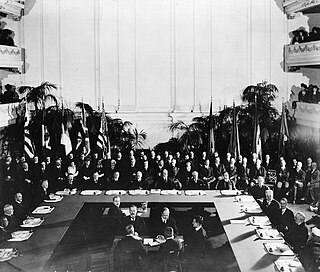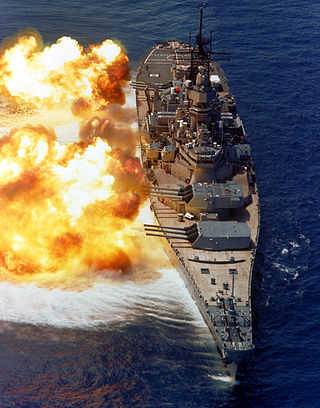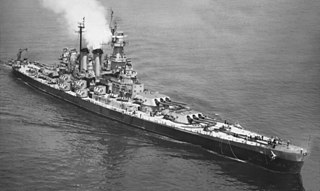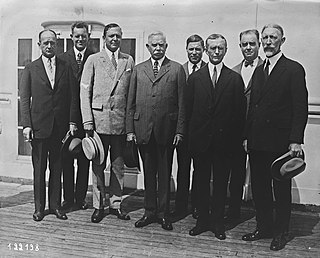
The Montana-class battleships were planned as successors of the Iowa class for the United States Navy, to be slower but larger, better armored, and with superior firepower. Five were approved for construction during World War II, but changes in wartime building priorities resulted in their cancellation in favor of continuing production of Essex-class aircraft carriers and Iowa-class battleships before any Montana-class keels were laid.

The Washington Naval Treaty, also known as the Five-Power Treaty, was a treaty signed during 1922 among the major Allies of World War I, which agreed to prevent an arms race by limiting naval construction. It was negotiated at the Washington Naval Conference in Washington, D.C. from November 1921 to February 1922 and signed by the governments of the British Empire, United States, France, Italy, and Japan. It limited the construction of battleships, battlecruisers and aircraft carriers by the signatories. The numbers of other categories of warships, including cruisers, destroyers, and submarines, were not limited by the treaty, but those ships were limited to 10,000 tons displacement each.

A heavy cruiser was a type of cruiser, a naval warship designed for long range and high speed, armed generally with naval guns of roughly 203 mm (8 inches) in calibre, whose design parameters were dictated by the Washington Naval Treaty of 1922 and the London Naval Treaty of 1930.

The London Naval Treaty, officially the Treaty for the Limitation and Reduction of Naval Armament, was an agreement between the United Kingdom, Japan, France, Italy, and the United States that was signed on 22 April 1930. Seeking to address issues not covered in the 1922 Washington Naval Treaty, which had created tonnage limits for each nation's surface warships, the new agreement regulated submarine warfare, further controlled cruisers and destroyers, and limited naval shipbuilding.

The Iowa class was a class of six fast battleships ordered by the United States Navy in 1939 and 1940. They were initially intended to intercept fast capital ships such as the Japanese Kongō class while also being capable of serving in a traditional battle line alongside slower battleships and act as its "fast wing". The Iowa class was designed to meet the Second London Naval Treaty's "escalator clause" limit of 45,000-long-ton (45,700 t) standard displacement. Beginning in August 1942, four vessels, Iowa, New Jersey, Missouri, and Wisconsin, were completed; two more, Illinois and Kentucky, were laid down but canceled in 1945 and 1958, respectively, before completion, and both hulls were scrapped in 1958–1959.

The North Carolina class were a pair of fast battleships, North Carolina and Washington, built for the United States Navy in the late 1930s and early 1940s.

The County class was a class of heavy cruisers built for the Royal Navy in the years between the First and Second World Wars. They were the first post-war cruisers constructed for the Royal Navy and were designed within the limits of the Washington Naval Treaty of 1922. Such ships, with a limit of 10,000 tons standard displacement and 8-inch calibre main guns may be referred to as "treaty cruisers".

Unrestricted submarine warfare is a type of naval warfare in which submarines sink merchant ships such as freighters and tankers without warning. The use of unrestricted submarine warfare has had significant impacts on international relations in regards to both the First World War and the Second World War. Its history has been dominated by German decision making. There have been attempts to limit the use of unrestricted naval warfare, with some dating back to before the turn of the 20th Century. Some of these have not succeeded in outlawing this type of warfare. To be deemed acceptable, naval attacks needed to follow prize rules, which called for warships to search merchantmen and place crews in "a place of safety" before sinking them. To follow these rules a submarine must surface, defeating the purpose of submarines and putting itself in danger of attack.

Myōkō (妙高) was the lead ship of the four-member Myōkō class of heavy cruisers of the Imperial Japanese Navy (IJN), which were active in World War II. She was named after Mount Myōkō in Niigata Prefecture. The other ships of the class were Nachi, Ashigara, and Haguro.

The Mogami class (最上型) was a ship class of four cruisers built for the Imperial Japanese Navy (IJN) during the 1930s. They were initially classified as light cruisers under the weight and armament restrictions of the London Naval Treaty. After Japan abrogated that agreement, all four ships were rearmed with larger guns and reclassified as heavy cruisers. All participated in World War II and were sunk.

The Fubuki-class destroyers were a class of twenty-four destroyers of the Imperial Japanese Navy. The Fubuki class has been described as the world's first modern destroyer. The Fubuki class set a new standard not only for Japanese vessels, but for destroyers around the world. They remained formidable opponents to the end of World War II, despite being much older than many of their adversaries.

The Lion class was a class of six fast battleships designed for the Royal Navy (RN) in the late 1930s. They were a larger, improved version of the preceding King George V class, with 16-inch (406 mm) guns. Only two ships were laid down before the Second World War began in September 1939 and a third was ordered during the war, but their construction was suspended shortly afterwards. The design was modified in light of war experience in 1942, but the two ships already begun were scrapped later in the year.

The Geneva Naval Conference was a conference held to discuss naval arms limitation, held in Geneva, Switzerland, in 1927. The aim of the conference was to extend the existing limits on naval construction which had been agreed in the Washington Naval Treaty. The Washington Treaty had limited the construction of battleships and aircraft carriers, but had not limited the construction of cruisers, destroyers or submarines.

A fast battleship was a battleship which in concept emphasised speed without undue compromise of either armor or armament. Most of the early World War I-era dreadnought battleships were typically built with low design speeds, so the term "fast battleship" is applied to a design which is considerably faster. The extra speed of a fast battleship was normally required to allow the vessel to carry out additional roles besides taking part in the line of battle, such as escorting aircraft carriers.

The South Dakota class was a group of four fast battleships built by the United States Navy. They were the second class of battleships to be named after the 40th state; the first were designed in the 1920s and canceled under the terms of the Washington Naval Treaty. Four ships comprised the class: South Dakota, Indiana, Massachusetts, and Alabama. They were designed to the same treaty standard displacement limit of 35,000 long tons (35,600 t) as the preceding North Carolina class and had the same main battery of nine 16"/45 caliber Mark 6 guns in three-gun turrets, but were more compact and better protected. The ships can be visually distinguished from the earlier vessels by their single funnel, compared to twin funnels in the North Carolinas.

A treaty battleship was a battleship built in the 1920s or 1930s under the terms of one of a number of international treaties governing warship construction. Many of these ships played an active role in the Second World War, but few survived long after it.

Allied submarines were used extensively during the Pacific War and were a key contributor to the defeat of the Empire of Japan.

A cruiser submarine was a very large submarine designed to remain at sea for extended periods in areas distant from base facilities. Their role was analogous to surface cruisers, cruising distant waters, commerce raiding, and scouting for the battle fleet. Cruiser submarines were successful for a brief period of World War I, but were less successful than smaller submarines during World War II. Large submarines remained vulnerable to damage from defensively equipped merchant ships (DEMS), were slow to dive if found by aircraft, offered a large sonar echo surface, and were less able to defensively maneuver during depth charge attacks.

The Erie-class gunboats were a class of gunboats built by the United States prior to World War II. The class was designed in 1932, and commissioned into the United States Navy in 1936: Erie (PG-50) and Charleston (PG-51). The Eries had a design speed of 20 knots and a main armament of four 6-inch (152 mm) guns in single mounts with four 1.1-inch (28 mm) quadruple mount anti-aircraft guns.

The Almirante Grau class was a class of two scout cruisers built for the Peruvian Navy between 1905 and 1907. Both ships remained in service until 1958.




















